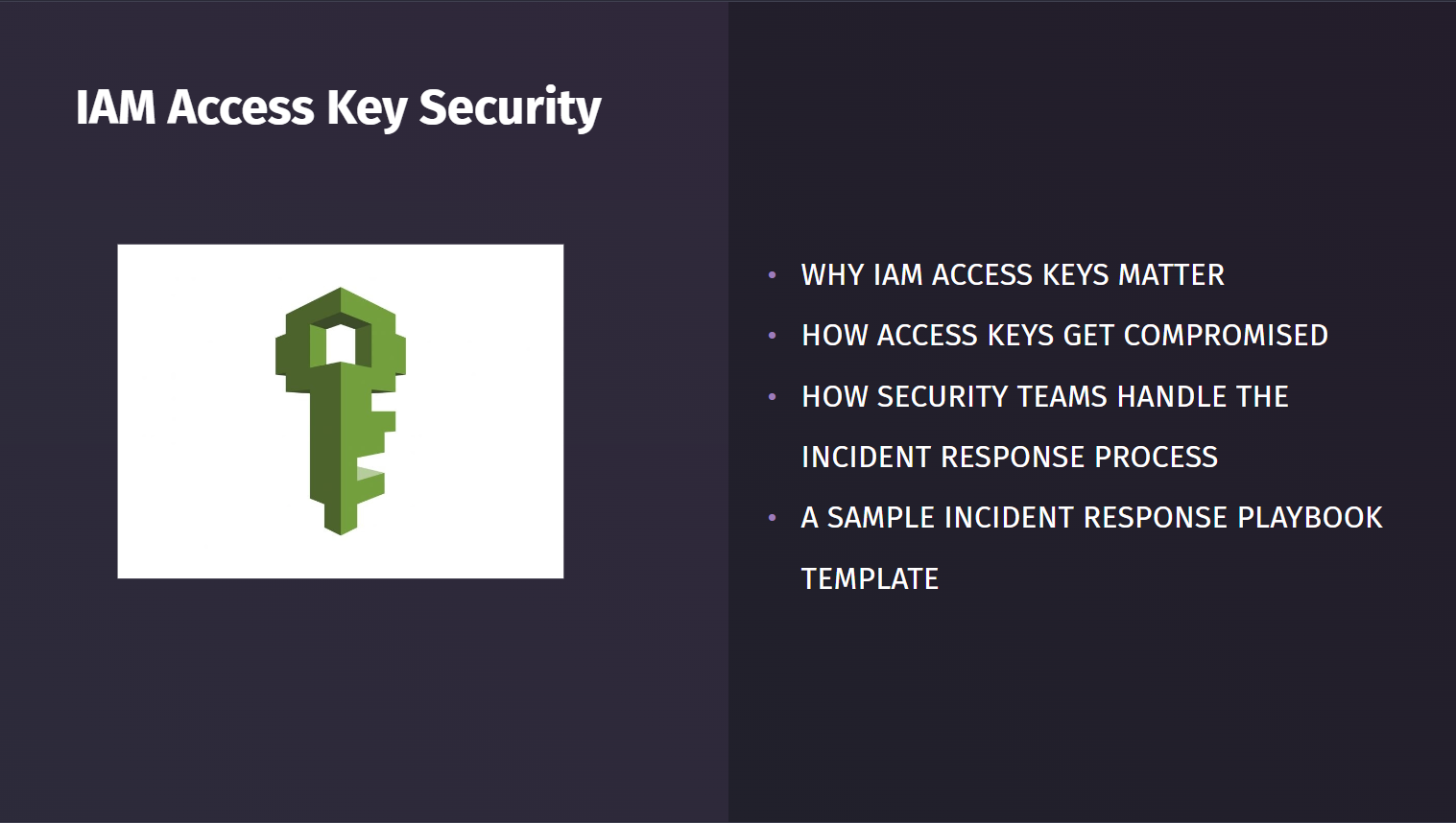AWS Incident Response: IAM Key Compromise Sample Playbook
 Henry McArdle
Henry McArdle
There has been an alarmingly high volume of compromised AWS IAM keys in recent months, with the majority of these being caused by lazy practices and lack of understanding of just how big a risk access keys play in the security of the organization. IAM keys are essentially API keys with permissions tied to them based on the user to whom the keys are assigned. The keys themselves are simple strings and can be thought of as a username & password combination. But why are they such as big risk?
The answer is simple and it pertains to what they are used for: programmatic AWS access. This means that scripts and applications are the primary users of these keys, and thus need to have them coded somewhere to access. Now the easiest way to do this is to just declare them in code like as follows:
AWS_ACCESS_KEY_ID = "AKIA...HSFG"
AWS_SECRET_ACCESS_KEY = "dgOFLDs...EAJ"
Most developers will use something like this code to develop projects, to provide a proof-of-concept to stakeholders. However, once a project is either approved or left to die, many times this code doesn't change. It works, so why change it? The code then gets so complex, that nobody sees the exposed keys or glosses over it on subsequent reads. There is no urgency, no care about the keys. Maybe the permissions are limited to a dev account, or maybe they are limited to sqs:CreateQueue, so who cares if they get compromised right?
Well, once permission creep sets in, the entire organization will care. That key that originally had SQS access now has S3 and IAM RW access. That key gets compromised where it is used to create brand new users with full-blown Admin rights.
You can see where the problem is. Code like this then gets uploaded to a public GitHub repo somewhere, and despite being taken down within a few minutes, scripts across the internet have already found it and began using it for stealing data and mining cryptocurrency.
Given the previous discussion around the problems of IAM keys, below is a sample playbook for responding to incidents should you ever get alerted upon a key's compromise. The following is a bare-minimum template to be used by security teams as a stepping stone for a more thorough, detailed policy.
Table of Contents
Introduction
Preparation
Detection
Containment
Eradication
Recovery
Lessons Learned
Conclusion
1. Introduction
Compromised AWS Identity and Access Management (IAM) keys can lead to unauthorized access, data breaches, and financial loss. This incident response playbook outlines the steps to take when you suspect or confirm a compromise of AWS IAM keys.
2. Preparation
2.1. Define Roles and Responsibilities
- Establish a dedicated incident response team and designate roles for identification, containment, eradication, and recovery.
2.2. Create an Incident Response Plan
- Develop a comprehensive incident response plan tailored to AWS IAM key compromises, detailing procedures, contacts, and communication.
2.3. Monitor and Alerts
Implement AWS CloudWatch alarms and custom alerts to monitor IAM key usage, failed login attempts, and suspicious activities.
Monitor CloudTrail logs extensively for abnormal usage.
2.4. Regularly Rotate Keys
- Enforce a key rotation policy to limit exposure in the event of a compromise.
3. Detection
3.1. Anomaly Detection
- Continuously monitor CloudWatch metrics and CloudTrail logs for unusual activity, such as unfamiliar IP addresses or unfamiliar API calls.
3.2. Suspicious Access Patterns
- Identify patterns of unusual access, such as multiple failed login attempts or excessive API calls.
3.3. Alerts
- Trigger alerts on suspicious activities and IAM key usage that deviates from the norm.
4. Containment
4.1. Disable Compromised Keys
- Immediately deactivate the compromised IAM keys to prevent further unauthorized access.
4.2. Limit Exposure
- Revoke unnecessary permissions, update policies, and remove access from compromised IAM users or roles.
4.3. Isolate Affected Resources
- Quarantine affected resources by adjusting security groups, network ACLs, and permissions.
5. Eradication
5.1. Investigate the Breach
- Conduct a thorough analysis to understand how the compromise occurred and which resources were affected.
5.2. Securely Delete Suspicious Activity
- Remove unauthorized resources and close security holes exploited by the attacker.
5.3. Review and Update Security Policies
- Reassess security policies and configurations to mitigate the risk of future compromises.
6. Recovery
6.1. Key Rotation
- Rotate all IAM keys and access credentials associated with compromised keys.
6.2. Reinstate Access
- Gradually restore access to impacted resources based on the investigation's findings.
6.3. Patch and Update
- Ensure that all systems and software are up to date to prevent recurring vulnerabilities.
7. Lessons Learned
7.1. Post-Incident Review
- Conduct a post-incident review to understand what happened, what worked, and what could be improved.
7.2. Documentation
- Update the incident response plan based on lessons learned during the incident.
7.3. Training
- Provide training for team members to enhance their incident response capabilities.
8. Conclusion
A swift and well-executed incident response is crucial when dealing with compromised AWS IAM keys. By preparing in advance, detecting suspicious activities, and following a structured incident response playbook, you can minimize the damage and mitigate the risks associated with such compromises. Continuously adapt and improve your response strategies to protect your AWS resources effectively.
Subscribe to my newsletter
Read articles from Henry McArdle directly inside your inbox. Subscribe to the newsletter, and don't miss out.
Written by

Henry McArdle
Henry McArdle
Lead Cloud Security Engineer @ Coremont. Enjoy piecing together solutions involving many moving parts. Big fan of the 'It finally works!' your brain yells when a complex project comes together. Love all things cloud, security, and containerized.